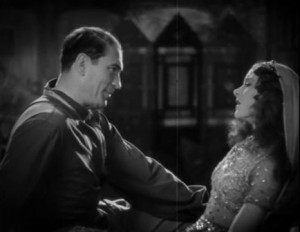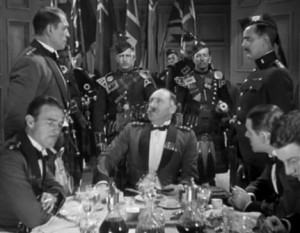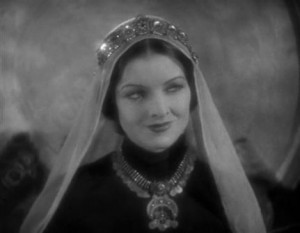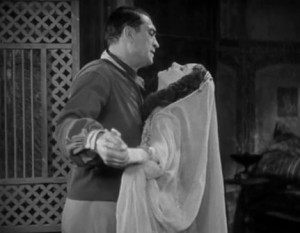 The Black Watch marked John Ford’s first sound film, and it shows. Like most films of the time when sound was in its infancy, some of the audio presentations are a bit amateurish and even artificial from eighty years after the fact. And, although some have derided John Ford’s first sound effort, I actually found it rather good. Amazingly, by the time this was made, John Ford had already made more than 50 films. Sadly, many of these early films have been lost- most likely for good.
The Black Watch marked John Ford’s first sound film, and it shows. Like most films of the time when sound was in its infancy, some of the audio presentations are a bit amateurish and even artificial from eighty years after the fact. And, although some have derided John Ford’s first sound effort, I actually found it rather good. Amazingly, by the time this was made, John Ford had already made more than 50 films. Sadly, many of these early films have been lost- most likely for good.
Remade in the 1955 Tyrone Power picture King of the Khyber Rifles, The Black Watch is set in the days of World War One. (Incidentally, I just saw that the last authentic Doughboy passed away earlier this year. This leaves just two remaining veterans of the First World War among the living.) Victor McLaglen and Myrna Loy star. Victor McLaglen was perhaps the first iconic figure in what ultimately became known ast the Ford Film Company, which constantly evolved throughout the director’s career. Later members would include Ward Bond, John Wayne, and Henry Fonda.
 Victor McLaglen, as Captain Donald King, is with his regiment, which is the Scottish Black Watch regiment, from which the film takes its name. They are on the eve of deployment to France in the Great War when Capt. King is called out and sent on a secret mission to India to infiltrate a rebel uprising led by Princess Yasmani, played by Myrna Loy. Strangely, although this is somewhat explained in the picture, she is a white woman in the middle of India.
Victor McLaglen, as Captain Donald King, is with his regiment, which is the Scottish Black Watch regiment, from which the film takes its name. They are on the eve of deployment to France in the Great War when Capt. King is called out and sent on a secret mission to India to infiltrate a rebel uprising led by Princess Yasmani, played by Myrna Loy. Strangely, although this is somewhat explained in the picture, she is a white woman in the middle of India.
 Even though this is “middle” John Ford, much of what later became his defined style is already well set. The best scenes are those which demonstrate the military traditions and reflect the history of the regiment. It is readily evident that this is the work of a mature director and if you know his work you will readily identify it as a John Ford picture. It is hard to overlook the presence of nostalgia and, as in many of his films, women play a lesser, but important role. Definitely another man driven picture.
Even though this is “middle” John Ford, much of what later became his defined style is already well set. The best scenes are those which demonstrate the military traditions and reflect the history of the regiment. It is readily evident that this is the work of a mature director and if you know his work you will readily identify it as a John Ford picture. It is hard to overlook the presence of nostalgia and, as in many of his films, women play a lesser, but important role. Definitely another man driven picture.
The movie plods along quickly but without any true distinction. For this viewer this wasn’t a negative so much. It is interesting enough at surface value but far more interesting if you are lucky enough to see this film are the technical aspects.
It is obviously black and white, so we lose the impact which color would later lend to John Ford’s later scenic vistas from Monument Valley. India (of course California playing India) would have looked vividly exciting as well surely. So on that count the viewer does loose out, but again, John Ford at this point isn’t the John Ford of The Searchers either. Some of the panoramic shots are quite distinctive as well.
 Much more interesting is the unintentional vignette we get into the transition from the silent era to talking pictures. Dialogue is extremely clipped and uneasy, and you can almost feel the tension of the on screen performers as they explore the realm of sound as well. All the dialogue is very audible and everyone is mindful of each other’s lines-overly so in fact. This results in no one talking over one another but also results in some awkward silences as well as one actor waits for the first to finish – sometimes a bit too long at times.
Much more interesting is the unintentional vignette we get into the transition from the silent era to talking pictures. Dialogue is extremely clipped and uneasy, and you can almost feel the tension of the on screen performers as they explore the realm of sound as well. All the dialogue is very audible and everyone is mindful of each other’s lines-overly so in fact. This results in no one talking over one another but also results in some awkward silences as well as one actor waits for the first to finish – sometimes a bit too long at times.
There also seems to be an overemphasis on music here as well, which surely is the result of the novelty impact of the ability to project sound as well. Suffice to say, after the first few instances of bagpipe music I rapidly grew to despise the blasted instrument. In retrospect, John Ford may have omitted a few of these bagpipe symphonies without harming the result.
 Also of note are the numerous title screens which linger as a result of the silent era. This creates an interesting juxtaposition of old and new technology. These screens appear with regularity but not so much as in earlier, exclusively silent pictures. We can already see the integration of sound into the future of the medium.
Also of note are the numerous title screens which linger as a result of the silent era. This creates an interesting juxtaposition of old and new technology. These screens appear with regularity but not so much as in earlier, exclusively silent pictures. We can already see the integration of sound into the future of the medium.
This one is rather hard to find and enjoy. I would disagree with those who disparage this given the newness of the medium at the time. Some even say it was remiss to let John Ford direct after The Black Watch. What viewers and critics must realize is that John Ford was, even at this extremely early stage in the sound era, an extremely well respected and tenured director.
Although there were directors (and actors) who could not manage the transition to sound, those of John Ford’s pedigree merited- and were given- several opportunities to adapt. I would say that John Ford not only adapted, but grew as an artist in the process.
Plus, The Black Watch turned a profit for the studio. Then, as now, that is all that truly matters.
My mother was on a visit to relatives in Meadville USA in 1929 from Scotland. She saw this movie on 3 August thought it very good with good India scenes. Maclagan played well she thought as did the leading lady. She enjoyed the old Scottish songs and the bagpipes as a treat, but she thinks they forgot that British railway engines didn’t have bells. She also wondered how many in the US audience would know what “a richt guid wallie wach” was. Information from her diary. Thank you for the information on the film. I am going to get a DVD if i can.